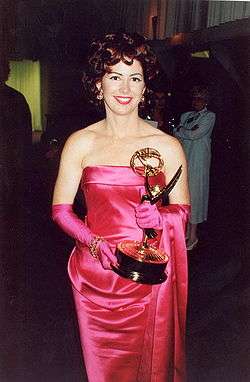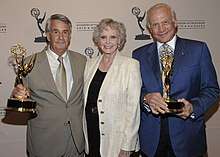Emmy Award
An Emmy Award, or simply Emmy, is an American award that recognizes excellence in the television industry. It is presented at numerous annual events held throughout the calendar year, each honoring one of the various sectors of the television industry. The two ceremonies that receive the most media coverage are the Primetime Emmy Awards and the Daytime Emmy Awards, which recognize outstanding work in American primetime and daytime entertainment programming, respectively. Other notable Emmy events include those honoring national sports programming, national news and documentary shows, and technological and engineering achievements in television, including the Primetime Engineering Emmy Awards. Regional Emmy Awards are also presented throughout the country at various times through the year, recognizing excellence in local and statewide television. In addition, the International Emmy Awards honor excellence in TV programming produced and initially aired outside the United States.
| Emmy Award | |
|---|---|
.jpg) Comedian Garry Shandling during the rehearsal of the 45th Primetime Emmy Awards, 1993 | |
| Awarded for | Excellence in the television industry |
| Country | United States |
| Presented by | ATAS/NATAS/IATAS |
| First awarded | January 25, 1949 |
| Website | ATAS Official Emmy website NATAS Official Emmy website IATAS Official Emmy website |
| Part of a series of articles about the |
| Emmy Award |
|---|
| Primetime Emmy |
| Daytime Emmy |
|
| Sports Emmy |
|
| Engineering Emmy |
| International Emmy |
| Regional Emmy |
| Other |
The Emmy is named after "immy", an informal term for the image orthicon tube that was common in early television cameras. The statuette depicts a winged woman holding an atom.[1] The Emmy is considered one of the four major American entertainment awards, the others being the Grammy (for music), the Oscar (for film), and the Tony (for theater).[2]
Three related, but separate, organizations present the Emmy Award: the Academy of Television Arts & Sciences (ATAS), the National Academy of Television Arts & Sciences (NATAS), and the International Academy of Television Arts and Sciences (IATAS).[3] The ATAS first awarded the Emmy in 1949 to honor shows produced in the Los Angeles area before it became a national event in the 1950s to honor programs aired nationwide. Over the next two decades, the ATAS, the NATAS, and the IATAS expanded the award to honor other areas of the TV industry, with each organization responsible for administering a particular set of Emmy competitions.[1]
History
The Los Angeles–based Academy of Television Arts & Sciences (ATAS) established the Emmy Award as part of an image-building and public relations opportunity.[1] The first Emmy ceremony took place on January 25, 1949, at the Hollywood Athletic Club, but solely to honor shows produced and aired locally in the Los Angeles area. Shirley Dinsdale has the distinction of receiving the very first Emmy Award for Most Outstanding Television Personality, during that first awards ceremony.[1] The term "Emmy" is a French alteration of the television crew slang term "Immy", the nickname for an "image orthicon", a camera tube once used in TV cameras.[4]
In the 1950s, the ATAS expanded the Emmys into a national event to honor shows aired nationwide on broadcast television. In 1955, the National Academy of Television Arts and Sciences (NATAS) was formed in New York City as a sister organization to serve members on the East Coast. While the ATAS maintained a separate ceremony to honor shows aired locally in the Los Angeles area,[5] the NATAS established regional chapters throughout the rest of the United States, with each one developing their own local Emmy ceremony for local programming.[1]
Originally, there was only one Emmy event held per year to honor shows nationally broadcast in the United States. In 1974, the first Daytime Emmy ceremony was held to specifically honor achievement in national daytime programming. Other area-specific Emmy events soon followed. Also, the International Emmy Awards, honoring television programs produced and initially aired outside the U.S., was established in the early 1970s.[1] Meanwhile, all Emmys awarded prior to the emergence of these separate, area-specific events are listed along with the Primetime Emmy Awards in the ATAS's official records.[6]
In 1977, due to various conflicts, the ATAS and the NATAS agreed to split ties. However, they also agreed to share ownership of the Emmy statue and trademark, with each responsible for administering a specific set of award events.[1] There was an exception regarding the Engineering Awards (those honoring individuals, companies, or scientific or technical organizations in recognition of significant developments and contributions to the engineering and technological aspects of television): The NATAS continues to administer the Technology & Engineering Emmy Awards, while the ATAS holds the separate Primetime Engineering Emmy Awards.
With the rise of cable television in the 1980s, cable programs first became eligible for the Primetime Emmys in 1988,[7] and the Daytime Emmys in 1989.[8] In 2011, the ABC Television Network cancelled the soap operas All My Children and One Life to Live, and sold the two shows' licensing rights to the production company Prospect Park so they could be continued on web television; this prompted NATAS to create a new Daytime Emmys category for the 2013 ceremony to honor such web-only series.[9] The ATAS also began accepting original online-only web television programs in 2013.[10]
Emmy statuette
The Emmy statuette, depicting a winged woman holding an atom, was designed by television engineer Louis McManus, who used his wife as the model. The ATAS rejected forty-seven proposals before settling on McManus's design in 1948. The statuette "has since become the symbol of the TV Academy's goal of supporting and uplifting the art and science of television: The wings represent the muse of art; the atom the electron of science."[11]
When deciding a name for the award, ATAS founder Syd Cassyd originally suggested "Ike", the nickname for the television iconoscope tube. However, "Ike" was also the popular nickname of World War II hero and future U.S. President Dwight D. Eisenhower, and the ATAS members wanted something unique. Finally, television engineer and the third academy president Harry Lubcke suggested the name "Immy", a term commonly used for the image orthicon tube used in the early cameras.[11] After "Immy" was chosen, it was later feminized to Emmy to match their female statuette.[11]
Each Primetime Emmy statuette weighs six pounds, twelve-and-a-half ounces (3.08 kg), and is made of copper, nickel, silver, and gold. The statue stands 15.5 inches (39 cm) tall with a base diameter of 7.5 inches (19 cm) and weight of 88 oz (2.5 kg). The Regional Emmy Award statuette is 11.5 inches (29 cm) tall with a base diameter of 5.5 inches (14 cm) and weight of 48 oz (1.4 kg). Each takes five and a half hours to make and is handled with white gloves to prevent fingerprints. The Primetime Emmy statues are manufactured by R.S. Owens & Company based in Chicago, Illinois, which was also charged with manufacturing the Academy Award statues until 2016, when AMPAS switched to Polich Tallix in Walden, New York.[12][13][14] The Regional Emmy Awards are made by both R.S. Owens & Company and Society Awards, a New York-based company that also makes the Golden Globe Awards.
As its trademark owners, the ATAS and the NATAS hold firm rules on the use of the "Emmy" image as well as its name. For example, the Emmy statuette must always appear facing left. Any copyright notice for the statue should read "ATAS/NATAS", listing both academies. Academy members must also obtain permission to use the statue image or name for promotional uses even though they are winners of the award. Furthermore, DVDs of Emmy-winning shows may reference the fact that they received an Emmy, but cannot use the statue image unless it is capable of being removed from all copies one year after the award is presented.[15][16]
Area-specific events
| Administering academy | Events |
|---|---|
| ATAS | Primetime, Primetime Engineering, Los Angeles Area, College TV |
| NATAS | Daytime, Sports, News & Documentary, Technology & Engineering, Regional (except for Los Angeles), National Student Production |
| IATAS | International |
Various area-specific Emmy competitions are held annually throughout the calendar year, ranging from honoring nationally televised shows to regionally and locally produced programs. Each event has its own set of award categories, nominating and voting procedures, and rules regarding voting committees. It is not uncommon for one ceremony to have some of the same category names that another Emmy event uses. (e.g. Primetime Emmy for Outstanding Drama Series and Daytime Emmy Award for Outstanding Drama Series).
A show that enters into one of the national Emmy competitions cannot also be entered into any of the others. For example, syndicated shows whose air times vary between media markets may be eligible for both the Daytime and Primetime Emmys, but cannot enter in both.[17] In general, a show is considered national if it reaches more than 50 percent of U.S. households; programs that do not reach at least 50 percent of the country may enter into the Regional Emmys instead. Web television shows are treated similar to syndicated shows: they must be available for downloading or streaming by more than 50 percent of the US national market to be eligible in one of the national Emmy competitions, and they can only enter into one of those national Emmy ceremonies.[18]
Regardless of which area-specific competitions in which one wins an Emmy, all winners are called an "Emmy Winner".
Primetime Emmys

The Primetime Emmys are presented in recognition of excellence in American primetime television programming. Ceremonies generally are held in mid-September, on the Sunday before the official start of the fall television season, and are currently broadcast in rotation among the ABC, CBS, NBC, and Fox networks.
Some award categories presented to behind-the-scenes personnel such as art directors, costume designers, cinematographers, casting directors, and sound designers are awarded at a separate Creative Arts Emmys ceremony held a few days earlier.
The Primetime Emmys are run and voted on by members of the ATAS. For most categories, members from each of the ATAS's branches vote around June to determine the nominees only in their respective categories. All members can however vote for nominations in the best program categories. The final voting to determine the winners is held in August.[19]
Daytime Emmys

The Daytime Emmy Awards, generally held in May or June, are presented in recognition of excellence in American daytime television programming. The first daytime-themed Emmy Awards were given out at the primetime ceremony in 1972, but the first separate awards show made just for daytime programming was not held until 1974.
Like the Primetime Emmys, a separate Creative Arts Emmy ceremony is also held a few days earlier to honor the behind-the-scenes personnel working in daytime television.
The Daytime Emmys are run and voted on by members of the NATAS. Voting is done by peer judging panels. Any active member of the NATAS who has national credits for at least two years and within the last five years is eligible to be a judge. Depending on the category, voting is done using either a ratings score criteria or a preferential scoring system.[20] All the drama acting categories have an additional preliminary voting round called the pre-nominations, where one or two actors from each show is selected to then move on and be considered for the primary nominations for the awards.[21]
Sports Emmys
The Sports Emmy Awards are presented by the NATAS for excellence in sports programming. The awards ceremony takes place every Spring, usually sometime in the last two weeks in April or the first week in May, and is held on a Monday night in New York City.
Voting is done by peer judging panels. The NATAS solicits anybody with significant experience in national sports production to serve as judges. The panels are organized so that they only have one representative from each corporate entity (i.e. ViacomCBS, Disney, NBCUniversal, Fox Corporation, WarnerMedia etc.) Most categories only have a single voting round using preferential scoring system. The top 5 entries in each category are announced as the nominations, and then the top entry is announced as the Emmy winner later at the awards ceremony.[22]
News and Documentary Emmys
The News & Documentary Emmy Awards are presented by the NATAS for excellence in national news and documentary programming. The awards ceremony takes place every fall.
Voting is done by peer judging panels. The NATAS solicits anybody with significant experience in national news or documentary reporting or production to serve as judges. Most categories have two voting rounds, with separate judging panels in each round. The top entries in each category are announced as the nominations, and then the top entry is announced as the Emmy winner later at the awards ceremony.[23]
Engineering Emmys

The Primetime Engineering Emmy Awards presented by the ATAS and the Technology & Engineering Emmy Awards presented by the NATAS are two separate competitions that honor individuals, companies, or to scientific or technical organizations in recognition of significant developments and contributions to the engineering and technological aspects of television.[24][25] Generally, the NATAS's Technology & Engineering Emmys ceremony is held in January, while the ATAS's Primetime Engineering Emmys are presented in October.
Each academy has its own separate panel of highly qualified, experienced engineers in the television industry to determine their respective award recipients. Among the ATAS's Engineering Emmy Award repertoire is the Philo T. Farnsworth Award, given to honor companies who have significantly affected the state of television and broadcast engineering over a long period of time.
Regional Emmys

There are 20 regional chapters located across the United States that each conduct regional awards to recognize excellence in all the regional television markets, including state to state programming as well as local news and locally produced shows. Nineteen of the regional chapters are affiliated with the NATAS,[26] while the Los Angeles-based ATAS acts as the regional chapter serving the Los Angeles area.[5][27]
In general, a show is considered regional if it does not reach more than 50 percent of U.S. households; programs that reach more than 50 percent of the country must enter into one of the national Emmy competitions instead.
The Regional Emmys are essential in helping NATAS and ATAS honor the works of deserving individuals in local TV through a regional outreach. Like the national awards, each region goes through their own rigorous nomination and voting procedures. Committees are formed to review entries for eligibility and high standards. Once accepted, each entry goes before different review committees, and their votes are cast to determine the final nominees. The final votes are then calculated by certified accounting firms within each region. Regardless of winning on a national or regional level, all recipients are Emmy Award winners.
Originally, each Regional Emmy Awards ceremony primarily focused on only honoring individuals in local news programming.[1] The regionals have since been expanded to encompass all locally and state to state-produced shows that receive less than fifty percent of the country's viewing audience.
| Regional chapter | States in region |
|---|---|
| Boston / New England | Maine, Massachusetts, New Hampshire, Rhode Island, and Vermont; Most of Connecticut |
| Chicago / Midwest | Parts of Illinois, Indiana and Wisconsin |
| Highlands Ranch / Heartlands | Colorado, Nebraska, Kansas, and Oklahoma; Parts of Wyoming |
| Dallas / Lone Star | Texas; Parts of New Mexico |
| Los Angeles (ATAS) | Greater Los Angeles only |
| Brecksville / Lower Great Lakes | Parts of Indiana, Ohio, and Pennsylvania |
| Southfield / Michigan | Michigan |
| Arkansas / Mid-America | Arkansas, Iowa, and Missouri; Parts of Illinois and Louisiana |
| Delaware / Mid-Atlantic | Delaware; Most of Pennsylvania; Parts of New Jersey and Ohio |
| Nashville / Midsouth | North Carolina, Tennessee |
| Maryland / National Capitol/Chesapeake Bay | Maryland, Virginia, and Washington, D.C. |
| New York / New York | New York; Parts of Connecticut and New Jersey |
| Alaska / Northwest | Alaska, Idaho, Montana, Oregon, and Washington |
| Kentucky / Ohio Valley | Kentucky and West Virginia; Parts of Indiana and Ohio |
| San Diego / Pacific Southwest | Most of Southern California (except Greater Los Angeles); Parts of Nevada |
| Rocky Mountain / Southwest | Arizona and Utah; Most of New Mexico; Parts of Southern California |
| San Francisco / Northern California | Northern California and Hawaii; Parts of Nevada |
| Atlanta / Southeast | Mississippi and South Carolina; Most of Alabama and Georgia |
| Suncoast | Florida; Parts of Alabama, Louisiana, and Georgia |
| Minnesota / Upper Midwest | Minnesota, North Dakota and South Dakota; Parts of Nebraska and Wisconsin |
International Emmys

The International Emmy Awards recognizes excellence in TV programming that is produced initially outside the United States. They have been presented annually by the IATAS since 1973.[28] The award ceremony generally takes place in November in New York City.
Any non-U.S. organization or individual (i.e. a network, a local or regional television station, producer, director, or writer) may submit a program (unless the show qualifies for the Non-English Language U.S. Primetime Program categories). Organizations or individuals who do not hold copyright ownership of a program must obtain consent from the rights owner before presenting a submission. This process is independent from membership.[29]
Student awards
The College Television Awards are presented by the ATAS in recognition of excellence in college student-produced works. College students nationwide can submit productions and receive recognition in such categories as Comedy, Documentary, Drama, Music, Newscasts, and Series.[30] Entries are first judged by members of the ATAS specializing in each respective field. Winners are then selected by Blue Ribbon Panels.[31] Any work submitted must include a form signed from a faculty advisor to verify that it was produced for a school related group, project, or class.[32]
Similarly, the National Student Production Awards are presented by the NATAS in recognition of excellence in high school student-produced works. High school students nationwide can submit productions and receive recognition in news, craft and programming categories.[33]
Highest achievement Emmys
- The Governors Award, the highest award presented by the ATAS, honors the achievements of an individual, company or organization whose works stand out with the immediacy of current achievement.[34]
- The Trustees Award, the highest award presented by NATAS, honors the unusual or enduring achievements of an individual.[35]
Other Emmys
- Public Service, for public service announcements and programming to "advance the common good"
- The Bob Hope Humanitarian Award, awarded by the ATAS Board of Governors to an individual in the industry whose humanitarian work have a lasting impact on society.[36]
See also
- Emmy related
- List of Daytime Emmy Award winners
- List of Primetime Emmy Award winners
- List of International Emmy Award winners
- Other similar awards
- List of American television awards
- British Academy Television Awards
- Golden Globe Award
- National Television Awards (UK)
- Screen Actors Guild Award
- Streamy Awards
- Directors Guild of America Award
- Producers Guild of America Award
- Writers Guild of America Award
- TCA Awards
- Canadian Screen Awards—film and television industry awards in Canada
- Logie Awards—television broadcasting industry awards in Australia
- CableACE Award—defunct award for Cable-based programming
References
- "A History of Emmy – The 1940s". Academy of Television Arts & Sciences. Retrieved January 24, 2017.
- "BBC Learning English | Emmy awards". Bbc.co.uk. September 17, 2007. Retrieved February 23, 2013.
- "Awards". Academy of Television Arts & Sciences. Archived from the original on September 14, 2008. Retrieved June 21, 2008.
- The Merriam-Webster New Book of Word Histories. Merriam-Webster Inc., 1991. p. 157
- "Academy of Television Arts & Sciences: National Academy". Retrieved October 6, 2009.
because our headquarters, the Academy of Television Arts & Sciences, are located in Los Angeles, our offices handle regional membership and awards for the Los Angeles area only
- "Advanced Primetime Awards Search". Academy of Television Arts & Sciences. Retrieved June 27, 2008.
- "Cable Executives Pleased Over Shot at Emmys". Los Angeles Times. July 15, 1988. Retrieved September 22, 2015.
- "NBC's 'Santa Barbara' Is Top Daytime Emmy Winner". Los Angeles Times. June 30, 1989. Retrieved September 22, 2015.
In the first year that they were eligible for Daytime Emmys, cable programs did not win any during Thursday's ceremonies. But the cable industry had picked up four of the golden statuettes at the non-televised [Creative Arts Emmy Award] event last Saturday
- "NATAS Hopes to Make 40th Daytime Emmys a Winner". broadcastingcable.com. December 24, 2012. Retrieved September 22, 2015.
- "Netflix Does Well in 2013 Primetime Emmy Nominations". The New York Times. July 18, 2013. Retrieved July 18, 2013.
- Parker, Sandra. "History of the Emmy Statuette". Academy of Television Arts and Sciences. Retrieved October 1, 2014.
- Award, Emmy. "History of the Emmy Statue". NATAS History. NATAS. Retrieved September 17, 2011.
- Award, Emmy. "R.S. Owens Manufactures Emmy Award". R.S. Owens and Co. manufacture the Emmy Awards. Fox Chicago. Retrieved September 17, 2011.
- Spadaro, Amanda (January 27, 2017). "Foundry seeks tax breaks in move to Walden." Times Herald-Record (Middletown, NY). Retrieved from RecordOnline.com, October 2, 2018.
- "ATAS Copyright and Trademark Policies". ATAS. Retrieved January 23, 2018.
- "NATAS Copyright and Trademark Policies". NATAS. Retrieved January 23, 2018.
- "63rd Primetime Emmys Rules and Procedures" (PDF). Academy of Television Arts & Sciences. Retrieved March 3, 2012.
Syndicated programs that have reached a cumulative audience of at least 50% of the total potential U.S. television audience during the eligibility period, but not 50% exclusively in Daytime or Primetime, may enter either in Daytime or Primetime, but not in both
- "41st Daytime Emmys Rules and Procedures" (PDF). National Academy of Television Arts & Sciences. Retrieved September 22, 2015.
Series and Specials (depending on the category), and their related craft achievements must have originally aired or been made available for viewing, downloading or streaming by more than 50% of the US national market
- "63rd Primetime Emmys Rules and Procedures" (PDF). Academy of Television Arts & Sciences. Retrieved February 29, 2012.
- "39th Daytime Emmys Rules and Procedures". National Academy of Television Arts & Sciences. Archived from the original on March 1, 2012. Retrieved February 29, 2012.
- "2010 Daytime Emmy Pre-Nominations Announced". Soap Opera Digest. Archived from the original on March 25, 2010. Retrieved March 15, 2010.
Those are the names put forth by each show for consideration to be nominated for the awards.
- "33rd Sports Emmys Rules and Procedures" (PDF). National Academy of Television Arts & Sciences. Archived from the original (PDF) on December 21, 2012. Retrieved March 2, 2012.
- "33rd News & Documentary Emmys Rules and Procedures" (PDF). National Academy of Television Arts & Sciences. Archived from the original (PDF) on December 21, 2012. Retrieved September 8, 2012.
- "Technology and Engineering Emmy Award: Scope and Procedures". National Academy of Television Arts & Sciences. Archived from the original on July 28, 2011. Retrieved September 8, 2012.
- "Primetime Engineering Emmy Awards".
- "National Academy of Television Arts & Sciences: Chapters". Archived from the original on September 22, 2009. Retrieved October 6, 2009.
- "Academy of Television Arts & Sciences: FAQ". Retrieved October 6, 2009.
The Academy also encompasses a Los Angeles branch whose members work in Southern California
- "20 years of the International Emmy Awards". thefreelibrary.com/.
- "Frequently Asked Questions (Submissions)" (PDF). International Academy of Television Arts and Sciences. Archived from the original (PDF) on April 6, 2017. Retrieved April 5, 2017.
- "About the College Television Awards". Academy of Television Arts & Sciences. Archived from the original on April 22, 2012. Retrieved February 2, 2014.
- "2014 College Television Awards categories". Academy of Television Arts & Sciences. Archived from the original on February 9, 2014. Retrieved February 2, 2014.
- "2014 College Television Awards rules". Academy of Television Arts & Sciences. Archived from the original on February 9, 2014. Retrieved February 2, 2014.
- "National Student Production Awards". National Academy of Television Arts and Sciences. Retrieved July 25, 2019.
- "Governors Award". Academy of Television Arts and Sciences. Retrieved July 25, 2019.
- "Trustees Award". National Academy of Television Arts and Sciences. Retrieved July 25, 2019.
- "George Clooney to Receive Bob Hope Humanitarian Award". Academy of Television Arts and Sciences. July 21, 2010. Retrieved July 13, 2014.
External links
| Wikimedia Commons has media related to Emmy Awards. |